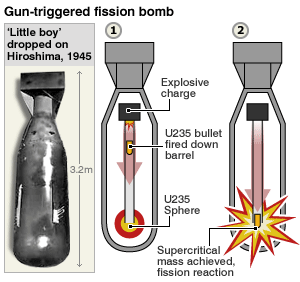A nuclear explosion is not always the greatest fear one faces. Radioactive fallout can be of more concern then the actual nuclear blast itself. Once a fission bomb explodes, the metals in the surrounding Earth become radioactive. These newly transformed elements then decay over the next few days releasing both alpha particles and gamma rays. Within seventy-two hours the majority of the elements have gone through enough half-life cycles to render them stable. About ninety percent of the gamma radiation will have dispersed within the first few hours of exposure. Ninety percent of the remaining substance will have dissipated within three days. These are known as activation products. Additionally, there are many more things that constitute the fallout plume.

Yet another constitute of the radioactive cloud is the remaining fuel that was not used in the nuclear explosion. This fuel is usually made up of Plutonium or Uranium. These substances have long half-lives so they don’t contribute to the direct amount of radiation. They do however emphasize
 the necessity to wear respirators while in the contaminated area. These substances are what cause the area to be uninhabitable for years after the initial explosion. As the Plutonium and Uranium decay, they release alpha and gamma particles that are corrosive to life in general.
the necessity to wear respirators while in the contaminated area. These substances are what cause the area to be uninhabitable for years after the initial explosion. As the Plutonium and Uranium decay, they release alpha and gamma particles that are corrosive to life in general.
The only true way to combat the fallout plume is with rain. Unfortunately, we haven’t progressed far enough to the point of weather control. If by luck, a radiated area is met with heavy rain fall, the plume with be contained. The rate at which the plume dissipates will also be much higher. The material will still remain highly radioactive on the ground, but the air will be left clean.
Sources: http://www.radpro.com/kpsarticle3.pdf —— http://www.gophoto.it/view.php?i=http://www.foxnews.com/images/245718/0_61_nuclear_blast.jpg#.UL2BuoOnmSo http://www.gophoto.it/view.php? ——i=http://media.treehugger.com/assets/images/2011/10/ROLAND_Nuclear_Winter.jpg#.UL2B54OnmSo ———








